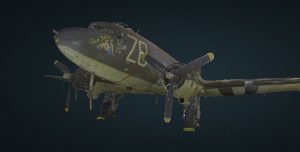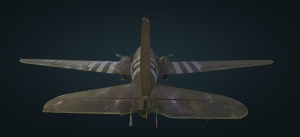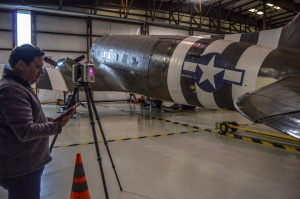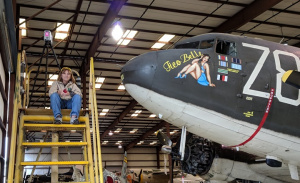



INSTRUCTIONS: Rotate the point cloud with your mouse.
LOCATION: Titusville, Florida
DATE: 2019
ABOUT THIS PROJECT
Although not as visible as the fighter and bomber aircraft of World War II, the Douglas C-47 Skytrain was critical to Allied success. The C-47 is a modified pre-war Douglas DC-3 commercial airliner. An extremely versatile and durable aircraft, it would be shortsighted to consider them nothing more than an aerial version of the Liberty Ship, ferrying much need war material to the frontlines. Its capabilities were not limited to transporting cargo. The C-47 participated directly in battle by dropping paratroopers, towing troop gliders, and evacuating the wounded.
While emblazoned with the moniker Tico Belle today, its official designation number was 42-100591 – recognizing it was constructed in 1942. The nose art it now carries is very reflective of that from the World War II era. On 6 June 1944, this aircraft was one of an expansive aerial armada that would participate in Operation Overlord (D-Day). It dropped members of the US Army 82nd Airborne Division near the town of St. Mere-Eglise to secure areas necessary to enable the advancement of troops from the landing beaches. This was vividly depicted in the classic 1962 motion picture The Longest Day. Research by the Valiant Air Command notes after D-Day, the aircraft would participate in Operation Dragoon, Operation Market Garden, the relief of Bastogne during the Battle of the Bulge, and Operation Varsity.
At the close of the Second World War, Germany was divided into four distinct zones of Allied occupation, the United States, United Kingdom, France, and the Soviet Union – this division would also be applied to Berlin. Tico Belle would also take part in one of the first major confrontations of the emerging Cold War, the Berlin Airlift. Tensions rose between the three Western Allies and the Soviet Union regarding numerous items, including monetary reform in Western Germany. In June 1948, to demonstrate their displeasure and their power, the Soviets blocked all road, train, and water access to West Berlin, which was located within the Soviet occupation zone of Germany. The Soviets only permitted three narrow air corridors into West Berlin, where the Allies would fly in all necessary materials to supply the civilian residents for the next 11 months. Tico Belle was one of many C-47s, C-54s, and other cargo aircraft that supplied the two million residents of West Berlin with more than 1.8 million tons of supplies and prevent the city’s unification with East Berlin.
The “Tico Belle” Douglas C-47 is the flagship of the Valiant Air Command Museum in Titusville, Florida. Valiant Air Command has an impressive collection of vintage aircraft, many of which are flightworthy. The VAC is also active in the restoration of aircraft and has a museum to assist in preserving the memories of those who flew and maintained historic military aircraft.
ChronoPoints would like to thank Valiant Air Command for their permission to scan Tico Belle. Special thanks to all the VAC volunteers for their onsite assistance and patience. We would also like to thank Matt Brown of Leica for his training on our new RTC360 laser scanner.
